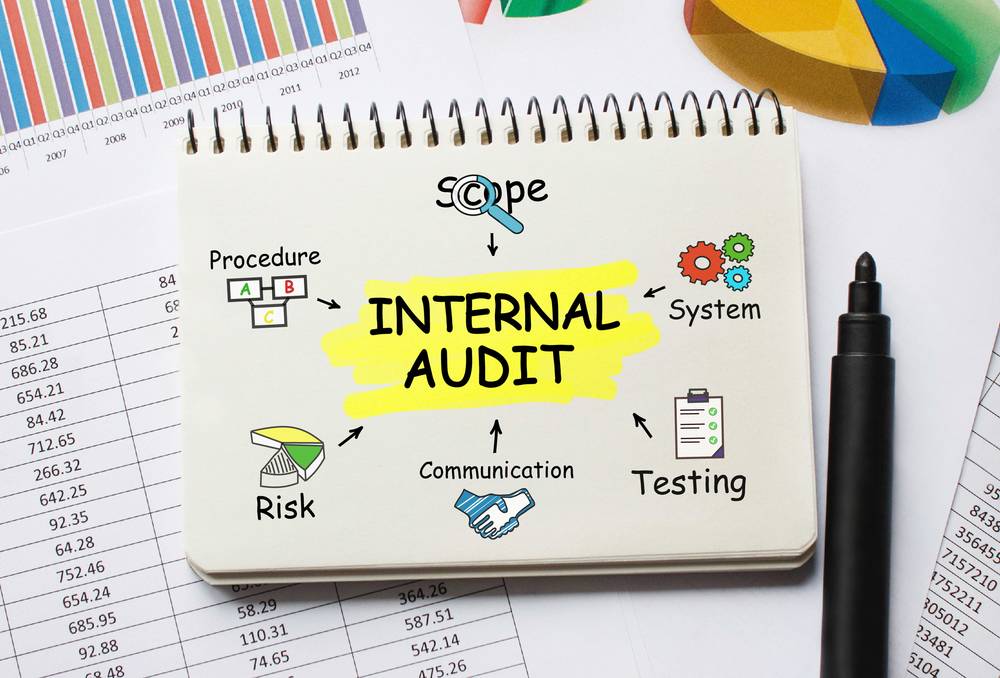 Last updated: May 16th, 2024 5:39 PM
Last updated: May 16th, 2024 5:39 PM
Internal Audit: Objectives, Types, & Process
Internal audit may be defined as an evaluation and analysis of a business operation that is conducted by the internal audit staff of the same business entity. Internal audits are considered as a part of the overall system of internal control that is established in an organisation and is conducted by professional internal auditors present in the company. This gives the management assurance concerning the control process in the organisation and helps detect inefficiencies or fraud early. This article discusses the Internal Audit of Companies, its types, role, and process. Get the compliance services for your business from IndiaFilings!! [shortcode_81]What is Internal Audit?
Internal auditing is an independent assessment function within a company that helps improve its operations. Internal auditors review a company's internal controls, governance, and risk management processes to identify areas for improvement and ensure they are functioning effectively. This can involve examining financial records, operational procedures, and compliance with regulations. Overall, internal auditing aims to add value to the organization by identifying weaknesses, recommending improvements, and promoting operational efficiency.Characteristics of Internal Audit
- An internal audit is performed to ensure that the system of internal controls instituted by a company's management is functioning as intended by its key managerial personnel and for the welfare of its members.
- It considers whether the business practices deployed by the company's officers help to manage the business prudently and meet the organisation's strategic objectives.
- It can cover both operational as well as financial issues. However, the internal audit process is generally understood to be limited and managed by any qualified person who can audit the governance of an organisation and the methodology by which it assesses and manages the risks it faces in the dynamic business environment. The internal auditor using this process is responsible for reporting to the management or audit committee of the company.
- Even though operating independently from other departments and involves reporting directly to the audit committee, internal audit is a function that remains within an organisation, i.e., the company’s employees.
- It involves performing audits of both financial and non-financial nature within a wide range of business areas, including those directed by the annual audit plan.
- It deals with the main risks facing the business and the action being taken to manage those risks effectively so that the organisation can achieve its various objectives. For example, the internal audit process evaluates risks threatening a company’s reputation, such as the employment of cheap labour in foreign countries, or strategic risks, such as producing too many products in comparison to available resources.
- It is limited to an organisation's governance, management controls over its operations, and risk management.
- It is conducted based on the personal resolve of the business owners to measure the operation’s efficiency as conducted by the business.
Objectives of Internal Audit
The following are the primary objectives of an organisation's internal audit.- Proper Control: Conducting an internal audit would ensure adequate control over all business activities, which would, in turn, result in maximum efficiency. Internal control would determine the degree of control over work.
- Accounting System: It would evaluate the organisation's accounting system. Internal audits include checking the proper authority for transactions such as the purchase, retirement, and disposal of fixed assets. They check against the results against entries to determine the actual facts and figures.
- Help Management: It helps management in significant ways. An internal auditor can point out an organisation's weaknesses and use them as a tool to make the necessary corrections. This would enable management to perform correctly.
- Working Review: It reviews a business's operations. They examine the current year's functioning in detail, locate weak points, and take corrective measures to ensure proper functioning.
- Asset Protection: It ensures asset protection. With the proper record of assets, an internal auditor can examine the valuation, verification, and possession of assets belonging to the company and confirm that the purchase or sale of assets was made under proper authority.
- Internal Check: It can evaluate the internal check system. With the division of duties amongst employees and when every organisation member works appropriately, an effective internal check system would exist, and the auditor's work would decrease. The internal auditor must only apply test checks to complete audit duty.
- Fair Statements & Error Scrutiny: It detects errors in accounting records. This would help management access the accounting records in order and minimise the chances of errors occurring in the records. The accounting team of an organisation would be able to rectify mistakes and prepare accounts at the end of the year to help the external auditor.
- Detection of Fraud: Conducting an internal audit can detect fraud in accounting books. Internal audits begin when the work of the accounting team is done. The accounts team often remains alert because there is insufficient time between recording and checking. Therefore, the detection of fraud is possible with internal audits.
- Determine Liability: Conducting an internal audit could determine the liabilities of employees. As the duties in an organisation are divided amongst the employees, it is easier to notice the negligence of employees. An internal audit can put a pin on the individual responsible for the error.
- Help in Independent Audit: It can help an independent audit. The external auditor has the option to rely on an internal auditor instead of conducting another check, saving both money and time.
- Performance Appraisal: It can check performance appraisal. It can be used as a tool to evaluate the workings of each management function so that the organisation can achieve the targets fixed in budgets and plans.
- Suggestions: Conducting an internal audit would provide suggestions for improving business activities. The internal audit staff would be able to suggest ways to overcome difficulties. However, an internal auditor cannot compel management to implement the suggestions.
- New Ideas: It can bring about new ideas concerning the procedures, marketing, financing, and other matters of the business. The auditors can offer new insights about various business matters that could be implemented to improve the business.
- Use of Resources: It aims to determine the right use of resources. Misusing resources would naturally increase the cost of doing a particular business. Proper resource use goes hand in hand with management efficiency.
- Accounting Policies: It would be able to examine the accounting policies of an organisation. An understanding of the accounting system and its procedures would be helpful in formulating effective audit plans and procedures. The internal auditor would be able to find weaknesses in the internal control and help fix the accounting policies.
- Special Investigation: It may be to conduct a special investigation concerning any business matter. An internal audit may be used to find the effectiveness of the function of the management.
Benefits of Internal Audit
The following are the benefits of conducting an internal audit in an organisation.- Proper Accounting Systems: Internal audits introduce an appropriate system of accounting. An accounting system comprises of a chain of activities in a company by which transactions are processed to maintain financial records. To achieve desirable results, orderly devices are required, which can be achieved through internal auditing.
- Better Management: It ensures better business management in the organisation. An auditor can point out areas of weakness in management. The business objectives can be achieved if there is proper internal control, internal check, and internal audit. It should be noted that management has the option to completely rely on internal audit for the best results.
- Progressive Review: It can help review the progress of the business. The figures from previous years are compared to those of the present year. The performance results of various similar companies can be considered and compared to determine the progress of the entity. An internal audit helps the management review the growth of the entity.
- Effective Control: It is essential to retain effective control over business activities. Control comes under management's functions and is related to the supervision and direction of ongoing operations. The manager can make the necessary changes according to the internal audit and remove the difficulties for a business's smooth functioning.
- Assets Protection: The protection of assets is possible through an internal audit. The management can only use the assets for the benefit of the business and not for private purposes. Internal auditing keeps an eye on embezzlement of cash, misappropriation use of stock and misuse of other assets from ever occurring.
- Division of Work: It can be conducted to apply the division of labour. This is necessary to monitor the activities of every employee, including the management. The auditor may choose to suggest ways to improve the business's performance.
- No Error and Fraud: Internal audits can be conducted to protect accounting records from errors and fraud. Accounting and auditing in a company go hand in hand, as the latter begins when the former is done. In such situations, the mistakes and deceptions committed by accounting personnel can be detected and rectified easily.
- Fixing Responsibility: Internal audits can establish the responsibilities of employees who perform poorly. Management establishes performance standards, and the internal auditor evaluates the results of all employees. This way, the concerned individuals can be held responsible for their work that does not meet the company's standards, and appropriate changes can be made.
- Helps External Auditing: The work performed by an internal auditor would be very helpful to an external auditor in conducting the audit. The internal and external audit procedures are very similar. However, an external auditor would be responsible for an external audit even if they choose to go through the internal audit report.
- Improved of Performances: An internal auditor would help improve the organisation's performance. The company's achievements in the previous year would be the basis of the budget preparations for the present year by drawing up income statements and balance sheets. Therefore, an internal audit improves a business's and its employees' performance.
- Proper Use of Resources: An internal audit checks the appropriate use of resources. The misuse of resources would undoubtedly increase the organisation's costs. The optimum use of resources in a company could be determined by controlling the cost of output. Internal audits can be considered a tool for using a company's resources in the best interests of the business.
- Investigation: Internal audits help to investigate various matters of the business. In situations that bring doubts, the internal auditor can be responsible for examining the facts and figures to confirm. Such investigations can be conducted at the request of the management of the company.
Types of Internal Audit
Internal audits are essential for organizations to assess their risks, improve operations, and ensure compliance with regulations. While the specific focus will vary depending on the organization's needs, there are several common types of internal audits:Financial/Controls Audits
This core internal audit type evaluates the effectiveness of an organization's internal controls over financial reporting. Internal auditors assess whether financial records are accurate and reliable, transactions are correctly recorded, and safeguards are in place to prevent fraud or errors. This helps ensure the integrity of the company's financial statements and protects against financial risks.Compliance Audits
These audits ensure the organization adheres to relevant laws, regulations, industry standards, and internal policies. This can involve environmental regulations, data privacy laws, human resource policies, or occupational safety standards. Compliance audits identify potential areas of non-compliance and recommend corrective actions to mitigate risks associated with fines, penalties, or reputational damage.Operational Audits:
Operational audits assess the efficiency and effectiveness of an organization's business processes. Internal auditors examine how well these processes are designed, implemented, and controlled. They identify areas for improvement, redundancies, or bottlenecks impacting performance. The goal is to optimize processes for increased efficiency, cost savings, and overall organizational performance.IT Audits:
With increasing reliance on technology, IT audits assess the organization's information technology (IT) infrastructure, controls, and security measures. This includes reviewing data security protocols, access controls, disaster recovery plans, and the overall effectiveness of IT systems. IT audits identify vulnerabilities and recommend improvements to safeguard sensitive data, ensure business continuity, and mitigate cyber security risks.Additional Specialized Audits:
Beyond these core types, internal audits can be tailored to address specific areas of concern within an organization. Examples include:- Construction Audits: These audits focus on construction projects, reviewing project management practices, contract compliance, cost controls, and potential schedule delays.
- Environmental Audits: These audits assess an organization's environmental compliance and impact. They may review waste management practices, energy consumption, and pollution control measures.
- Investigative Audits: These audits investigate specific allegations of fraud, misconduct, or irregularities within the organization.
Internal Audit vs External Audit
The table below gives you the information regarding the differences between internal audit and external audit,| Feature | Internal Audit | External Audit |
| Who Performs It | Employees of the organization or an internal audit department | Independent accounting firm hired by the company |
| Purpose | Improve operations, identify areas for improvement, and ensure effectiveness of internal controls | Provide an independent opinion on the fairness and accuracy of the company's financial statements |
| Scope | Broad range of areas including financial reporting, operational processes, compliance, risk management, and governance | Primarily focuses on financial records, transactions, and accounting practices |
| Focus | Forward-looking, identifying potential risks and opportunities for improvement | Historical, providing assurance on past financial performance |
| Reporting | Reports to senior management and the board of directors | Reports to shareholders and regulatory bodies |
| Impact on Financial Statements | Does not directly impact published financial statements | May result in adjustments to the financial statements |
| Independence | May have some familiarity with the company's operations, potentially impacting objectivity | Completely independent of the company, ensuring objectivity |
| Frequency | Can be conducted continuously or periodically throughout the year | Typically conducted annually |
| Regulation | Not mandatory for all companies, but may be required by some regulations or good governance practices | Mandatory for publicly traded companies and some private companies based on size or risk profile |
Internal Audit Process
The internal Audit process contains four phases of activities: Planning and risk assessment, Fieldwork, Reporting and communication, and Follow-up. Find below the brief description for each phase of activity:Planning and Risk Assessment
- Identify Audit Needs: The internal audit department or chief audit executive (CAE) works with management and the board to identify areas requiring audit focus. This may involve analyzing risk assessments, industry trends, and past audit findings.
- Develop the Audit Plan: Based on the identified needs, the internal audit team creates a detailed plan outlining the specific objectives, scope, methodology, and resources needed for each audit.
- Risk Assessment: A risk assessment prioritizes audit areas based on their potential impact on the organization. This helps ensure the internal audit focuses on areas with the highest risk of issues.
Fieldwork
- Gather Information: The internal audit team gathers information through various techniques, including:
- Interviews: Discuss processes and controls with relevant personnel.
- Document Review: Examining policies, procedures, financial records, and other relevant documents.
- Observation: Witnessing processes firsthand to understand their practical application.
- Testing of Controls: Performing tests to assess the effectiveness of internal controls in mitigating risks.
- Analyze Findings: The team analyses the information gathered to identify potential weaknesses, inefficiencies, or areas of non-compliance.
Reporting and Communication
- Draft Audit Report: The internal audit team prepares a comprehensive report outlining the audit objectives, scope, methodology, findings, conclusions, and recommendations for improvement.
- Management Response: Management reviews the report and provides a written response outlining their plan to address the identified issues.
- Communication with Stakeholders: The internal audit department communicates the audit findings and recommendations to senior management and the board of directors. This may involve presenting the report and discussing its implications.
Follow-Up
- Monitoring Action Plans: The internal audit team monitors the implementation of management's action plan to address the audit findings. This ensures corrective actions are taken and identified weaknesses are addressed.
- Continuous Improvement: The internal audit process is cyclical. The findings and recommendations from previous audits inform future risk assessments and audit planning, promoting continuous organisational improvement.
Limitations of Internal Audit
The following are the limitations of an internal audit.- Staff Shortage: One of the few limitations of an internal audit is the staff shortage. A reasonable audit staff must examine the records and conduct a proper internal audit. The lack of a team would restrict the organisation from reaping the benefits of the internal audit.
- Time Lag: As internal audits begin when accounting end, there is a significant time lag between recording and checking entries.
- Error: An internal audit's limitation is that undetected errors may remain in the books of accounts, as this depends upon the expertise of the internal audit staff. If the staff is experienced and competent, the chances of an error going undetected are very low. In the case of poor audit staff, there is no guarantee that the audited accounts are free from errors.
- Responsibility: The limitation of an internal audit is that management does not feel that it is their responsibility to complete the formalities of the audit. The audit staff could offer suggestions for the proper functioning of a business. However, the top-level management would not necessarily pay attention to the suggestions offered, which would be of no help or a loss to the company.
- Duties: The whole purpose of an internal audit may fail if the duties of the audit staff are not adequately divided and implemented using a method that ensures the optimum utilisation of organizational resources.
Conclusion
Internal audits are an independent assessment function within a company that helps improve its operations. Internal auditors review a company's controls, governance, and risk management processes to identify areas for improvement and ensure they are functioning effectively. This can involve examining financial records, operational procedures, and compliance with regulations. Overall, internal auditing aims to add value to the organization by identifying weaknesses, recommending improvements, and promoting operational efficiency. IndiaFilings experts help your company meet all the necessary compliance requirements!! [shortcode_81]Popular Post

In the digital age, the convenience of accessing important documents online has become a necessity...

The Atalji Janasnehi Kendra Project that has been launched by the Government of Karnataka...

The Indian Divorce Act governs divorce among the Christian couples in India. Divorce...

When an individual has more than a single PAN card, it may lead to that person being heavily penalised, or worse,...

Employees Provident Fund (PF) is social security and savings scheme for employee in India. Employers engaged...


